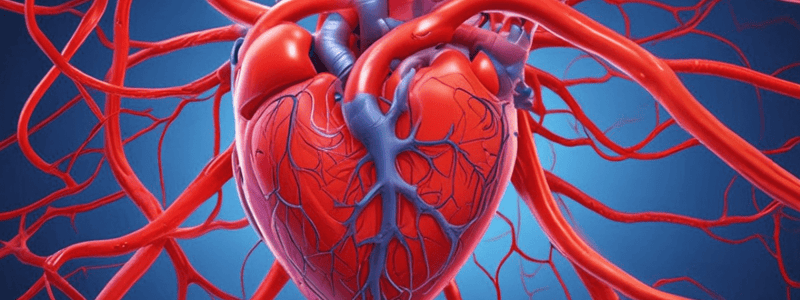Podcast
Questions and Answers
During exercise, why does the coronary blood flow increase 3 to 4 times?
During exercise, why does the coronary blood flow increase 3 to 4 times?
- To compensate for the decreased coronary blood flow during systole
- To meet the increased energy demands of the heart (correct)
- To allow for more efficient oxygen extraction by the coronary vessels
- To reduce the risk of myocardial ischemia
What happens to coronary blood flow during systole in the left ventricle muscle?
What happens to coronary blood flow during systole in the left ventricle muscle?
- It remains constant to ensure steady oxygen delivery
- It fluctuates according to diastolic changes
- It increases to provide more oxygen to the heart muscle
- It falls to a low value due to compression of blood vessels by muscle contraction (correct)
Why is the subendocardial portion of the left ventricle the most common site of myocardial ischemia and infarction?
Why is the subendocardial portion of the left ventricle the most common site of myocardial ischemia and infarction?
- It has higher O2 consumption at rest
- It receives the least amount of coronary blood flow
- It has fewer anastomoses between large arteries (correct)
- It has a high rate of O2 extraction ratio
Why does a narrowed coronary vessel with atherosclerosis lead to severe angina pain during exertion?
Why does a narrowed coronary vessel with atherosclerosis lead to severe angina pain during exertion?
What percentage of the total cardiac output is directed towards coronary blood flow during resting conditions?
What percentage of the total cardiac output is directed towards coronary blood flow during resting conditions?
In coronary arteries, what is the function of anastomosis?
In coronary arteries, what is the function of anastomosis?
What characterizes coronary arteries as functionally END arteries?
What characterizes coronary arteries as functionally END arteries?
During which phase of the cardiac cycle does blood flow rapidly through the coronary arteries?
During which phase of the cardiac cycle does blood flow rapidly through the coronary arteries?
What is the primary control mechanism for coronary blood flow?
What is the primary control mechanism for coronary blood flow?
Which of the following metabolites is NOT involved in the regulation of coronary blood flow?
Which of the following metabolites is NOT involved in the regulation of coronary blood flow?
What is the mechanism behind autoregulation of coronary blood flow?
What is the mechanism behind autoregulation of coronary blood flow?
Within what range of mean arterial pressure does autoregulation maintain consistent coronary blood flow at rest?
Within what range of mean arterial pressure does autoregulation maintain consistent coronary blood flow at rest?
Which of the following statements about coronary blood flow is TRUE?
Which of the following statements about coronary blood flow is TRUE?
Which of the following is NOT a factor affecting coronary blood flow?
Which of the following is NOT a factor affecting coronary blood flow?
Which of the following statements accurately describes the origin of the coronary arteries?
Which of the following statements accurately describes the origin of the coronary arteries?
Which of the following statements accurately describes the distribution of the right coronary artery?
Which of the following statements accurately describes the distribution of the right coronary artery?
Which of the following statements accurately describes the distribution of the left coronary artery?
Which of the following statements accurately describes the distribution of the left coronary artery?
Which of the following statements accurately describes the venous drainage of the heart?
Which of the following statements accurately describes the venous drainage of the heart?
Which of the following statements accurately describes the capillary density in the heart?
Which of the following statements accurately describes the capillary density in the heart?
Which of the following statements accurately describes the effect of systole on the blood flow in the subendocardial plexus?
Which of the following statements accurately describes the effect of systole on the blood flow in the subendocardial plexus?
Which of the following statements accurately describes a characteristic of the coronary vessels?
Which of the following statements accurately describes a characteristic of the coronary vessels?
Which of the following statements accurately describes the relationship between arterial blood pressure (ABP) and coronary blood flow?
Which of the following statements accurately describes the relationship between arterial blood pressure (ABP) and coronary blood flow?
During which phase of the cardiac cycle is the coronary blood flow to the left ventricle maximal?
During which phase of the cardiac cycle is the coronary blood flow to the left ventricle maximal?
Which of the following statements accurately describes the direct effect of sympathetic stimulation on coronary vessels?
Which of the following statements accurately describes the direct effect of sympathetic stimulation on coronary vessels?
Which of the following hormones causes direct coronary vasoconstriction?
Which of the following hormones causes direct coronary vasoconstriction?
Which of the following statements accurately describes the effect of parasympathetic stimulation on coronary vessels?
Which of the following statements accurately describes the effect of parasympathetic stimulation on coronary vessels?
During which phase of the cardiac cycle is the coronary blood flow to the right ventricle maximal?
During which phase of the cardiac cycle is the coronary blood flow to the right ventricle maximal?
What percentage of oxygen is typically extracted from the coronary arteries by the heart at rest?
What percentage of oxygen is typically extracted from the coronary arteries by the heart at rest?
Which of the following statements accurately describes the effect of catecholamines on coronary blood flow?
Which of the following statements accurately describes the effect of catecholamines on coronary blood flow?
Which of the following statements accurately describes the characteristics of the coronary blood vessels?
Which of the following statements accurately describes the characteristics of the coronary blood vessels?



